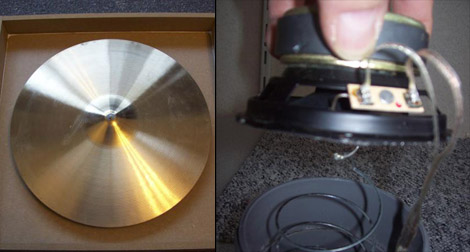
If you’re running your own recording studio, you’re going to need a lot of gear that seems excessively esoteric to the non-musically inclined. A rack full of synth gear looks just like any other cabinet of technology you would find in a server room. Electronic music is, for the most part, very utilitarian looking, but there are a few pieces that add a very nice aesthetic touch to any studio. [Peter] made two great looking pieces of hardware – both reverbs – that significantly add to the decor of his studio. As a bonus, they also sound really good.
[Peter]’s spring reverb (Dutch, Google translate) works just the same as any other spring reverb; a speaker puts some music into a slightly stretched spring, and this sound is picked up by another transducer at the opposite end. For this build, [Peter] used a Slinky and a piece of PVC pipe left over from a bathroom remodel. Adding a few jacks, pots, and a preamp, [Peter] had a very nice and extremely large spring reverb.
The plate reverb (translation) is also a staple of pro recording studios around the globe. This reverb is somewhat similar to a spring reverb, except the spring is replaced with a tuned metal plate. [Peter] used a cymbal from a drum set for this piece of kit. Two speakers are attached to the back of the cymbal, one feeds a sound into the cymbal, the other speaker picks up those sounds and sends it to the mixing board.
There’s a lot of really cool musical DIY projects over on [Peter]’s site, along with a few audio demos for each of his DIY projects. We’ve included his reverb demos after the break, feel free to give those a listen.
Thanks go to [geekabit] for sending this one in.
Plate reverb:
Spring reverb:















Was the cymbal being driven or played actively. This is more instrument than effect. It would be nice to hear speech fed thru it, wet only to gauge the clarity or lack of it. This is how I refined the sigma drive spring reverb that I made. OP amp has spring driver coil in feedback path to -input. This corrects for all the nonlinear responses. Speech feed thru wet is still very intelligible. I have many Acutronics and other organ reverb units form junking organs. A pair resides in a gutted cassette deck except for pair of jacks in and out and panel with knob and level led meters for drive control. Sounds professional and has even done PA gigs, but normally is in the main quad room. Google hotsprings reverb and sigma drive.
I’m curious – why go to all this trouble building physical devices when presumably you can replicate the same effect in software? It is after all an electronic music studio, so digital effects shouldn’t be out of the question! Or am I missing something?
Different materials will have different characteristics (tone, outside noises, harmonics, etc.), many of which can be very difficult to reproduce via computer.
true. i like hardware but impulses could be taken for use in a convolution reverb vst for convenience. or sharing. (hint).
Physical reverb devices tend to be pretty nonlinear, so simulating with convolution tends to end up with 2 results:
– It either sounds really boring (i.e no boing on a spring reverb)
– The impulse is taken in a non linear range, and therefore is heavily distorted.
Because it’s cool, because we old farts like old stuff and because digital is repeatable while analog only roughly is, therefore you can build a $10 analog effect pedal, claim it is unique (which would be true) then sell it at $200.
Also, building analog stuff teaches much more than digital schematics do.
Sometimes its more about the journey than the destination. That, and the fact that thirty years ago you couldn’t just download a reverb app for free, you either had to pay thousands of dollars for the hardware, or build one yourself….
Because while you can approximate a spring or plate reverb in software, these devices potentially have a unique sound. And because you can :)